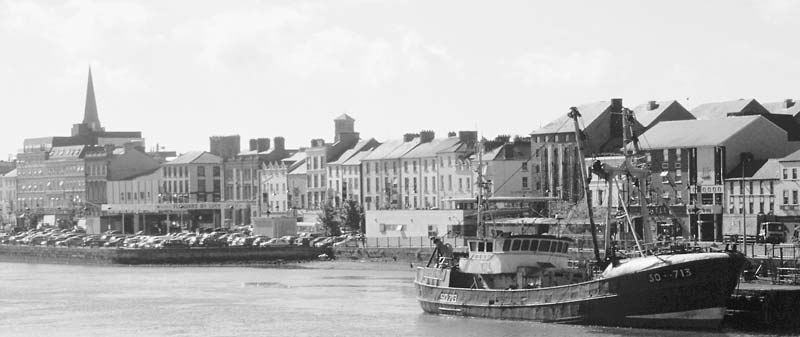
The best overnight stop in southeast Ireland is the historic Viking port and Norman beachhead town of Waterford. From here, you can explore the varied sights of County Wexford.
This region has a pastoral serenity and a strong history of trading from its sheltered ports facing England. The Vikings built the ports and developed the trade routes. Their cousins, the Normans, came along 200 years later and carefully fortified the ports. In 1170, King Henry II visited his new Irish realm with a huge fleet, calling Waterford the “Gateway to Ireland.” With more efficient farming techniques and advanced military technology, the Normans cranked up their dominant culture and shoved the locals aside.
But the Irish made them fight to hang on to it. Like medieval Fort Apaches, Norman-fortified tower-house castles dot the landscape in this area more so than in most other parts of Ireland. And throughout your travels here, you’ll see evidence of the region’s Norman (French) roots in its high concentration of family names with old Norman prefixes: De Berg, De Lacy, Devereux, Fitzgilbert, Fitzsimmons, Fitzgerald, and so on.
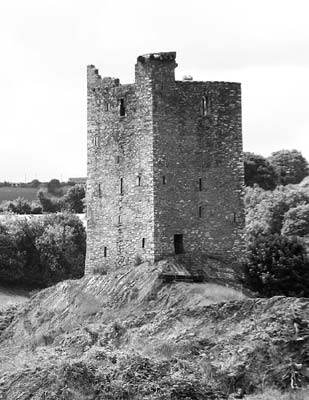
And how about this: Zorro was from Wexford. Or so say some historians, who claim that the inspiration for the colorful fictitious character was locally born, multilingual, 17th-century Catholic adventurer William Lamport. Lamport ran afoul of the English, fled to Spain, became a pirate, and joined a Spanish regiment fighting Swedes in the Thirty Years War. He was sent to Mexico as a spy (El Zorro means “the fox”) but was executed for sympathizing with native slaves against the Mexican Inquisition.
The oldest city in Ireland, Waterford was once more important than Dublin. Its three fine history museums reflect this. But today, while tourists associate the town’s name with its famous crystal, the 45,000 residents are quick to remind you that the crystal is named after the town, not vice versa (come for the crystal, stay for the history). That said, Waterford is a plain, gray, workaday town. Pubs outnumber cafés, and freighters offload cargo at the dock. It’s a dose of gritty Ireland, with fewer leprechauns per capita than other Irish destinations. Wandering the back streets, you’re reminded that until a couple of generations ago, Ireland was one of the poorest countries in Western Europe.
A day is enough time for Waterford’s compact historic core. Visit the Waterford Crystal Visitor Centre early or late to avoid the big-bus-tour crowds at midday. Beyond that, your best activity is the historic walk (at 11:45 or 13:45 in peak season), followed by a visit to the branch of the Waterford Museum of Treasures housed in Reginald’s Tower. History buffs may want to dig deeper with visits to the other two nearby branches of this three-museum complex: Chorister’s Hall (medieval life) and Bishop’s Palace (Georgian to modern age). To feel the pulse of contemporary Waterford, hang out on Barronstrand Street—the town’s pedestrian artery—and stroll through its big, modern shopping mall. All of these sights (and the TI) are within a triangular four-block area. The three museums, Waterford Crystal Visitor Centre, and the Theatre Royal are clustered behind Reginald’s Tower, facing a street called The Mall.
Waterford’s main drag runs along its ugly harbor, where you’ll find the bus station and easy parking lots (€1.80/hour, best overnight lot—entry next to bus station—costs €5 for a stay from 17:00-11:00; pay as you exit to get gate to open, must have exact change in coins). Some of the harborfront lots have an automated pay station where you pay before exiting (check the payment/exit procedures as you walk out of the lot).
All recommended accommodations and sights are within a 10-minute walk of the harbor. The TI and Reginald’s Tower are opposite Millennium Plaza, at the far eastern end of the harborfront from Rice Bridge. The stubby three-story Victorian clock tower marks the middle of the harbor. It’s also the start of the pedestrian Barronstrand Street, which runs two blocks inland to the town square.
The TI sits on the harborfront, where Greyfriars Street meets Parade Quay, facing a modern, white, tent-like structure covering a raised stage called Millennium Plaza (July-Aug Mon-Fri 9:00-18:00, Sat 10:00-18:00, Sun 11:00-17:00; April-June and Sept-Oct Mon-Fri 9:00-18:00, Sat 10:00-18:00, closed Sun; Nov-March Mon-Sat 9:15-17:00, closed Sun; 120 Parade Quay, tel. 051/875-823, www.discoverwaterfordcity.ie). As with all Irish TIs, it’s basically a counter where clerks tell you about places that they “endorse” (that is, get money from).
Post Office: It’s on Parade Quay (Mon-Fri 9:00-17:30, Sat 9:00-13:00, closed Sun).
Laundry: Snow White launderette is at 61 Mayor’s Walk (Mon-Sat 9:30-13:30 & 14:30-17:00, closed Sun, tel. 051/858-905).
Bookstore: The multilevel Book Centre, right off the main square, is a fun browse and has a cozy soup and sandwich café on an upstairs balcony (Mon-Sat 9:00-18:00, Fri until 21:00, Sun 13:00-17:00, 25 John Roberts Square, tel. 051/873-823).
Shopping: The Irish Handmade Glass Company features artisans trained at the old Waterford Crystal factory, who work right in front of you fashioning unique crystal creations (Mon-Sat 9:00-17:00, closed Sun, 11 Henrietta Street, tel. 051/858-914, www.theirishhandmadeglasscompany.com).
Taxis: Consider Street Cabs Ltd. (117 Parade Quay, tel. 051/877-778). Rapid Cabs operates local taxis (tel. 051/858-585), and Rapid Express offers coaches to Dublin’s airport (tel. 051/872-149).
Jack Burtchaell and his partners lead informative, hour-long, historical town walks that meet at the TI every day at 11:45 and 13:45—or join the tour as it swings by the Granville Hotel at 12:00 and 14:00 (just show up, pay €7 at the end, mid-March-mid-Oct only, tel. 051/873-711, www.jackswalkingtours.com). The tour is an entertaining walk from the TI to the Waterford Crystal Visitor Centre, giving you a good handle on the story of Waterford.
You can take this town for a two-hour spin with Waterford Cycling Tours (€15, June-Aug Mon-Fri at 11:00 and 19:00, Sat also at 14:00, Sept-May Sat only at 11:00 and 14:00; call ahead to arrange meeting spot and bike delivery, Donal Jacob, tel. 086/129-2724, www.waterfordcyclingtours.ie).
With a tradition dating back to 1783, Waterford was, until recently, the largest and most respected glassworks in the world. But the economic downturn of 2008 shattered the market for luxury items like crystal, and sadly, the huge Waterford Crystal factory outside town closed in January of 2009.
The good news for crystal enthusiasts is that the company was bought by American investors, who opened a new, scaled-down factory in the town center in 2010. While 70 percent of Waterford Crystal is now manufactured by cheaper labor in Poland, Slovenia, and the Czech Republic, the finest glass craftsmen still reside here, where they create “prestige pieces” for special-order customers. The one-hour tour of this hardworking little factory is a joy; it’s more intimate than the old, larger factory. You’re encouraged to interact with the craftsmen.
Cost and Hours: Tours-€13, depart every 30 minutes, April-Oct Mon-Sat 9:00-16:15, Sun 10:00-16:15, shorter hours off-season, call to confirm; shop free and open longer hours; tel. 051/317-000, www.waterfordvisitorcentre.com.
Getting There: The Waterford Crystal Visitor Centre is conveniently located on a street called The Mall, an easy one-block walk south of Reginald’s Tower.
Visiting the Factory: The tour begins with a bit of history and a look at an impressive six-foot-tall crystal grandfather clock. It then loses momentum as you’re ushered into a glitzy and pointless five-minute fireworks film montage set to a techno beat. But things pick up again as your guide takes you into the factory to meet the craftsmen in their element. Glassblowers magically spin glowing blobs of molten crystal into exquisite and recognizable shapes in minutes. If you get dizzy blowing up balloons for a kid’s party, consider the lung stamina that these craftsmen display (hot crystal is a lot heavier to heave with a breath than thin rubber balloons). Watch closely as the glassblower puts his thumb over the opening between breaths to keep the heat and pressure inside the blob constant.
Heavy molten crystal has an intentionally high lead content (it’s what distinguishes fine crystal from common glassware). A cooling-off stage allows the crystal to set. Then glass cutters deftly cradle the fragile creations against diamond-edged cutting wheels, applying exactly enough pressure to ensure that the grooves are replicated with surgical skill. Interestingly, the craftsmen are not at risk of slicing themselves on the wheels, which cut hard crystal but not soft flesh (I still can’t figure that one out). The glasscutters will be glad to demonstrate if you ask.
Watch the skilled cutters muscle rough unfinished pieces—weighing as much as bowling balls—and cut intricate patterns. The crystal vases and bowls may look light and delicate, but hold an unfinished piece (with its lead-enhanced heft) and you’ll gain a new appreciation for the strength, touch, and hand-eye coordination of the glasscutters.
Afterward, visit the glittering salesroom, surrounded by hard-to-pack but easy-to-ship temptations. Take a look at the copies of famous sports trophies (they make backups of their most important commissions, just in case).
Waterford presents its impressive history in a three-museum complex called the Museum of Treasures, with the locations just a damsel’s handkerchief drop from each other. This “Viking Triangle” rests on the original triangular-shaped Viking fort section of town. Each branch is connected to the other by a two-minute walk (the museum’s tagline is “Vikings to Victorians: 1,000 years of history in 1,000 paces”). To see the branches in historical sequence, first visit Reginald’s Tower on the harborfront to understand the Viking roots of the city. Then stroll up The Mall to find Chorister’s Hall Medieval Museum, a modern structure tucked behind the Theatre Royal. This branch shows Norman and Tudor artifacts above an original 13th-century vaulted wine cellar. Finally, right next door, you can visit the imposing Bishop’s Palace, a fine mansion full of everything Waterford from 1700 to the present. Few Irish towns can claim a meatier bite of Irish history than Waterford.
Note: Entry to Reginald’s Tower is covered by the Heritage Card (see “Sightseeing Passes,” here). The Chorister’s Hall and Bishop’s Palace are not, but they do offer a combo-ticket for entry into both.
This oldest part of the oldest town in Ireland is named after Regnall, the first (Norwegian) Viking leader of Waterford, who built a fortified oaken tower here in A.D. 914 and later invaded Jorvik (York, England). Dating from the late 1100s, the stone Norman tower you see today replaced the wooden one and was once the most important corner of the town wall. The tower is Ireland’s oldest intact building and the first made with mortar. Today, its four floors creak with Viking artifacts.
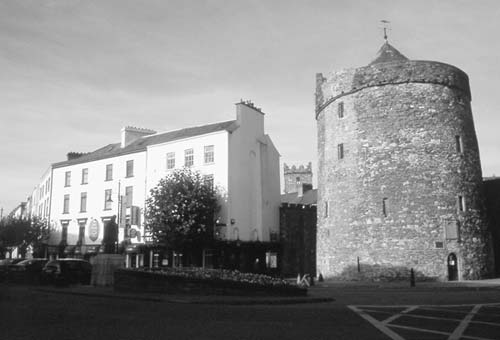
Cost and Hours: €3; includes guided tour any time upon request—ask for the one-hour version, which adds a historical walk around the block to French Church; daily Easter-Oct 9:30-17:30, Nov-Easter 10:00-17:30, last entry 30 minutes before closing, tel. 051/304-220, www.waterfordtreasures.com.
Visiting the Museum: Before you enter, look for the cannonball embedded high above the entrance, courtesy of Cromwell’s siege cannons.
Once inside, you’ll find an interesting Viking town model opposite the ticket counter. Upstairs a display of early coins explains how the Vikings introduced the concept of coinage to the Irish after they eventually settled down and set up trade posts. Look for the tiny Kite Brooch that delicately blends both Scandinavian and Irish styles. In their day, brooches were considered badges of status, and this one’s owner must have been at the top of the heap. As you climb the narrow stone stairways, watch your head (people were shorter 800 years ago). And be sure to go all the way to the top floor, where an informative 10-minute animated video traces the evolution of the town from muddy fort to modern city.
The statue outside (in the middle of the street) is of Thomas Francis Meagher (see sidebar), whose short, hell-bent-for-leather life took him on precarious adventures from Waterford to Tasmania to Nicaragua to Montana and, finally, to an unknown watery grave.
This middle branch of the museum triumvirate uses its three floors to focus on life in Waterford from the Norman invasion of the late 1100s to the Williamite English triumph of the late 1600s. Your visit is enhanced by an excellent free audioguide that plays automatically as you move from room to room (don’t miss the changing images it displays).
Cost and Hours: €7, €10 combo-ticket with Bishop’s Palace; June-Aug Mon-Sat 9:30-18:00, Sun 11:00-18:00; Sept-May Mon-Sat 10:00-17:00, Sun 11:00-17:00; last entry one hour before closing, tel. 051/304-500, www.waterfordtreasures.com.
Visiting the Museum: Begin by descending under the modern building and into an original wine vault cellar from the 1200s (long on atmosphere but otherwise empty).
Ride the elevator to the top floor to see a grand collection of well-described Anglo-Norman artifacts. The Great Charter Roll of 1372 was compiled to reinforce Waterford’s claim to a monopoly of the lucrative wine-import trade. Check out the wall-size copy of the famous painting depicting the pivotal marriage of Norman leader Strongbow to Irish princess Aoife, then bring it to life on your audioguide. Detailed town models and an informative 10-minute audiovisual presentation complete the history here.
Down one floor, you’ll learn how religion played out on Waterford’s historic stage. Watch this floor’s audiovisual presentation first to understand the broader context of this town’s role in Irish history. Then feast your eyes on “Heaven’s Embroidered Cloths,” a collection of priestly vestments produced in Medici Florence, decorated in affluent Bruges, and shipped to conflicted Waterford. Hidden under a flagstone in the floor of Christ Church Cathedral during a siege, they were rediscovered 123 years later during renovation.
Housed in the former mansion (built 1743) of the local Protestant bishop (with his Christ Church Cathedral looming right behind it), this museum presents a grand sweep through the history of Waterford since 1700. The refined interior hints of the privileged lifestyle of the holy resident and contains the world’s largest collection of old Waterford glass. The bishop would meet you at the top of the grand stairway if you were an upper-class visitor, greet you at his office doorway if you were a middle-class merchant, and not budge from the chair behind his desk if you were lower-class. Under no circumstances would he come downstairs to greet anyone.
Cost and Hours: €7, €10-combo ticket with Chorister’s Hall, same hours as Chorister’s Hall—see earlier, tel. 051/304-500, www.waterfordtreasures.com.
Tours: Your visit will be enriched by the entertaining 45-minute free tours conducted by actors in period dress, who inhabit the palace as servants of the bishop (June-Aug hourly 10:00-17:00, Sept-May hourly 11:00-16:00).
Visiting the Palace: You’ll work your way through three floors spiced with characters like Waterford-born action hero Thomas Francis Meagher (see sidebar). You’ll learn why the province of Newfoundland in Canada owes over 50 percent of its population to immigrants from Waterford. And if you’ve ever wondered what bull baiting is, you’ll be filled in on this equally cruel (and long outlawed) Irish version of a bullfight.
In 1793, the English king granted Ireland the Irish Relief Act, which, among other things, allowed the Irish to build Catholic churches and worship publicly. With Catholic France (30 million) threatening Protestant Britain (8 million) on one side, and Catholic Ireland (6 million) stirring things up on the other, the king needed to take action to lessen Irish resentment. Allowed new freedom, the Irish built this interesting cathedral in 1796. It’s Ireland’s first Catholic post-Reformation church and its only Baroque church. The building was funded by wealthy Irish wine merchants who were flourishing in Cádiz, Spain. Among its treasures are 10 Waterford Crystal chandeliers.
Cost and Hours: Free, daily 8:00-19:00.
Nearby: The cathedral faces Barronstrand Street, which leads from the clock tower on the harborfront through the pedestrian-friendly town square to Patrick Street. The street separates the medieval town (on your left when the river is behind you) from the 18th-century city (on your right). A river once flowed here—part of the town’s natural defenses just outside the old wall. The huge shopping center that dominates the old town was built right on top of the Viking town. In fact, the center is built over a church dating from 1150, which you can see at the bottom of the escalator (behind the glass, next to the kiddie rides).
The Protestant cathedral, with 18th-century Georgian architecture, is the fourth church to stand here. Look for the exposed Gothic column six feet below today’s floor level, a remnant from an earlier church where the Norman conqueror Strongbow was married (see sidebar on here).
Wander over to the macabre tomb of 15th-century mayor James Rice, which bears a famous epitaph: “I am what you will be, I was what you are, pray for me.” To emphasize the point, he requested that his body be dug up one year after his death (1482) and his partially decomposed remains be used to model his likeness, now seen on the tomb’s lid...complete with worms and frogs.
Cost and Hours: Free though a €2 donation is requested, Mon-Fri 10:00-17:00, Sat 10:00-16:00, closed Sun except for services, tours available on request.
Waterford’s small but lively Theatre Royal claims a 225-year tradition. Given the dearth of other nighttime options in Waterford beyond pubs, it’s worth checking out their schedule of plays, concerts, and light opera during your stay (€15-30 tickets, located on The Mall across from the Waterford Crystal Visitor Centre, tel. 051/874-402, www.theatreroyal.ie).
Waterford is a working-class city. Cheap accommodations are fairly rough; fancy accommodations are venerable old places that face the water. I recommend one historic option, two modern options, and two budget options below (little else in town splits the difference). Many find sleepy Ardmore, an hour southwest down the coast, a smaller and more scenic home base (see here).
$$ The Granville Hotel is Waterford’s best and most historic hotel, grandly overlooking the center of the harborfront. The place is plush, from its Old World lounges to its 98 extravagant rooms (Sb-€80-100, Db-€90-160, Tb-€120-200, super breakfasts, possible discounts online, Meagher’s Quay, tel. 051/305-555, www.granville-hotel.ie, stay@granville-hotel.ie).
$$ Dooley’s Hotel, a more modern, family-run place on the harbor with 113 big rooms, can be less expensive than the Granville but is still high-quality (Sb-€69-119, Db-€89-169, Tb-€109-199, lower prices possible if you book directly on hotel’s website, Merchant’s Quay, tel. 051/873-531, www.dooleys-hotel.ie, hotel@dooleys-hotel.ie).
$$ Treacys Hotel is another family-run, modern hotel on the waterfront, close to the Rice Bridge and with pleasant, earth-toned rooms (Sb-€59-69, Db-€79-99, Tb-€99-119, Wi-Fi, 1 Merchants Quay, tel. 051/877-222, www.treacyshotelwaterford.com, res@thwaterford.com).
$ Mayor’s Walk B&B is a well-worn, grandmotherly place that takes you right back to the 1950s. Bob and Jane Hovenden rent four humble, economical rooms with sincere hospitality (S-€28, D-€50, T-€75, cash only, Wi-Fi, 12 Mayor’s Walk, tel. 051/855-427, www.mayorswalk.com, mayorswalk@gmail.com).
$ Portree Guesthouse, just across the bridge from the train station, combines 24 basic budget rooms upstairs with 10 dorm beds in its basement hostel (bed in dorm-€20, Sb-€32-40, Db-€59-69, Tb-€79-99, Qb-€119-130, breakfast-€7, Wi-Fi, guest kitchen in hostel section, parking behind, 10-11 Mary Street, tel. 051/874-574, www.portreeguesthouse.ie, info@portreeguesthouse.ie).
For something livelier than tired pub grub, consider these good restaurants found on less-frequented back streets. They’re small and popular with locals.
Emiliano’s Ristorante Italiano is the most romantic place in town, hidden on a tiny lane behind Reginald’s Tower. They serve a great selection of tasty pasta dishes and fine wines (€17-23 two- or three-course early-bird specials before 19:00, open Tue-Sun 12:30-14:30 & 17:00-22:00, closed Mon, 21 High Street, tel. 051/820-333).
Koliba, a friendly Polish place with a B.Y.O.B. liquor policy, serves hearty Eastern European fare, including potato pancakes stuffed with pork goulash and topped with sour cream (two-course early-bird special before 19:00, Tue-Sun 12:00-20:30, Fri-Sat until 22:00, closed Mon, 11a O’Connell Street, tel. 087/171-8688).
The relaxed Bodega is my favorite wine bar, run by laid-back Cormac in a warm-glow Mediterranean atmosphere (Mon-Sat 12:00-22:00, closed Sun, 54 John Street, tel. 051/844-177).
On the Harborfront: The Granville Hotel’s carvery is your best €10 lunch option if you’re looking for a central waterfront location (daily 12:30-14:30, otherwise good bar food daily 10:30-21:00, Meagher’s Quay).
Pub Grub and Music: Waterford’s staple food seems to be pub grub. Several typical pubs serve dinner in the city center. For your musical entertainment, hum a medley of your favorite show tunes. For some reason, not much live music exists in town. Ask at your hotel, or just wander around, read the notices, and follow your ears. Anything with a pulse will be found on George Street, Barronstrand Street, and Broad Street.
Supermarket: Dunnes Store in the shopping center is your best grocery option (Mon-Sat 9:00-19:00, Thu-Fri until 21:00, Sun 12:00-18:00).
From Waterford by Train to: Dublin (8/day, 2.5 hours), Kilkenny (6/day, 45 minutes). For details, see www.irishrail.ie.
By Bus to: Cork (almost hourly, 2.25 hours), Kilkenny (2/day, 1 hour), Rosslare (4/day, 1.5-2.5 hours), Wexford (5/day, 1 hour). Waterford bus station info: Tel. 051/879-000. For details, see www.buseireann.ie.
The southeast corner of Ireland, peppered with pretty views and historic sites, is easily accessible to drivers as a day trip from Waterford. While most of the sights are mediocre, five worth considering are within an hour’s drive of Waterford.
The dramatic Hook Head Lighthouse—capping an intriguing and remote peninsula—comes with lots of history and a great tour. The Kennedy Homestead is a pilgrimage site for Kennedy fans. These two stops involve more back-roads navigation, but they feel more intimate (study your map south of the town of New Ross).
The Dunbrody Famine Ship in New Ross gives a sense of what 50 days on a “coffin ship” with dreams of “Americay” must have been like. The Irish National Heritage Park near Wexford is like a Knott’s Berry Farm...circa the Stone Age. And the National 1798 Centre in Enniscorthy explains the roots of the Irish struggle for liberty. These three stops, which are no strangers to tour buses, form an easy driving triangle whose legs are N-25, N-11, and N-30.
If you’re driving from Waterford to Kilkenny, consider a visit to the ruins at Jerpoint Abbey and Kells Priory on the way (see the “Between Kilkenny and Waterford” section in the Kilkenny and the Rock of Cashel chapter.)
New Ross, Enniscorthy, and Wexford are each less than 30 minutes apart, connected by fast roads. The Kennedy Homestead is a 10-minute drive south of New Ross, and the lighthouse is a 45-minute trip from Waterford to the end of the Hook Peninsula. All are well-signposted and easy to find...except for Hook Head Lighthouse (see details later).
Connecting Dublin with Waterford, you could visit many of these sights in a best-of-County Wexford day en route. On a quick trip, the sights are not worth the trouble by public transit. If you’ll be spending the night, blue-collar Enniscorthy (with decent hotels and B&Bs) provides a good glimpse of workaday Ireland.
If connecting Waterford to Hook Head, use the car-ferry shortcut from Passage East to Ballyhack (€8, 5-minute crossing, runs continuously April-Sept Mon-Sat 7:00-22:00, Sun 9:30-22:00; Oct-March Mon-Sat 7:00-20:00, Sun 9:30-20:00). To reach the ferry from Waterford, take Lombard Street (near Reginald’s Tower) south, and follow it all the way to Passage East (it becomes R-683).
This claims to be the oldest operating lighthouse in Europe. According to legend, St. Dubhan arrived in the fifth century and discovered the bodies of shipwrecked sailors. Dismayed, he and his followers began tending a fire on the headland to warn future mariners. What you see today is essentially a structure from the 12th century, built by the Normans, who first landed five miles up the east coast (at Baginbun Head, in 1169). They established Waterford Harbor—a commercial beachhead for the rich Irish countryside they intended to conquer. This beacon assured them safe access.
Today’s lighthouse is 110 feet tall and looks modern on the outside. (It was automated in 1996, and its light can be seen for 23 miles out to sea.) But it’s actually 800 years old, built on a plan inspired by the lighthouse of Alexandria in Egypt—one of the seven wonders of the ancient world.
Cost and Hours: Visit by tour only-€6; fine 30-minute tours depart every half-hour June-Aug, every hour off-season, last tour usually at 16:00; daily June-Aug 9:30-18:00, May and Sept 9:30-17:30, Oct-April 9:30-17:00; tel. 051/397-055, www.hookheritage.ie.
Getting There: The lighthouse can be a bit tricky to find. But if you follow the brown Hook Scenic Route signs south of Ballyhack and remind yourself that you’re on a narrow peninsula with the lighthouse at the southern tip, you’ll be funneled straight there (more or less).
Visiting the Lighthouse: Since it’s a working lighthouse, it can be toured only with a guide. When you’re inside—seeing the lighthouse’s black-stained, ribbed, vaulted ceilings and stout, 10-foot-thick walls—you can almost feel the presence of the Cistercian monks who tended this coal-burning beacon for the Normans. Climbing 115 steps through four levels rewards you with a breezy, salt-air view from the top.

Oliver Cromwell passed through here to secure the English claim to this area (see “The Curse of Cromwell” sidebar). He considered his two options, and declared he’d take strategic Waterford “by Hook or by Crooke.” Hook is the long peninsula with the lighthouse. Crooke is a little village on the other side, just south of Passage East.
There’s a decent cafeteria and a shop with fliers explaining other sights on the peninsula. Kids-at-heart can’t resist climbing out on the rugged rocky tip of the windy Hook Head.
Patrick Joseph Kennedy, President John F. Kennedy’s great-grandfather, left Ireland in 1858. Distant relatives have turned the family homestead into a little museum/shrine for Kennedy pilgrims. Physically, it’s not much: A barn and a wing of the modern house survive from 1858. JFK and his entourage visited here in June of 1963, a few months before he was assassinated. While it’s now just a private home, anyone interested in the Kennedys will find it worth driving the long narrow lane to see.
Cost and Hours: €7.50; daily 9:30-17:30, until 17:00 Oct-March; café on site, tel. 051/388-264, www.kennedyhomestead.com.

Getting There: It’s four miles (6 km) south of New Ross near Dunganstown (look for sign off R-733, long one-lane road). Don’t confuse the Kennedy Homestead with the nearby JFK Arboretum—a huge park with 4,500 species of trees and a grand six-county view. It’s nice if you like trees and plants, but there’s no Kennedy history there.
Visiting the Homestead: You’ll first view a short video, which is fascinating if you like Kennedy stuff: five minutes of JFK’s visit to the farm while he was being hosted for tea by his distant relatives. He’s then whisked away by helicopter to continue his triumphant tour of the country. After the video, you’re free to peruse the barn, lined with Kennedy-in-Ireland memorabilia and photos that detail the history of the dynasty.
Permanently moored on a river in the tiny port of New Ross, this ship was built as a re-creation of similar vessels that sailed to America full of countless hungry Irish emigrants. The Dunbrody is a full-scale reconstruction of a 19th-century three-masted bark built in Quebec in 1845. It’s typical of the trading vessels that originally sailed empty to America to pick up goods; during the famine, ship owners found that they could make a little money on the westward voyage. On board, extended families camped out for 50 days on bunk beds no bigger than a king-size mattress. Commonly, boats like this would arrive in America with only 80 percent of their original human cargo (in worst cases, only 50 percent). Those who succumbed to “famine fever” (often typhus or cholera) were dumped overboard, and the ships gained their morbid moniker: “coffin ships.”
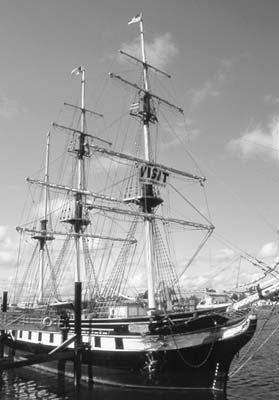
Cost and Hours: €8.50, daily April-Sept 9:00-18:00, Oct-March 10:00-17:00, 45-minute tours go 2/hour, last tour starts one hour before closing, upstairs café handy for lunch with nice views of the ship, tel. 051/425-239, www.dunbrody.com.
Getting There: The Dunbrody is in New Ross, near the Kennedy Homestead. During work hours, you’ll need to feed the parking meters in the lot (€1/hour, free on Sun).
Visiting the Ship: Your visit starts with an audiovisual presentation on the life Irish emigrants were leaving behind, followed by coverage about the building of the vessel. Then you’ll follow an excellent guide on board the ship, encountering a couple of grumpy passengers who tell vivid tales about life onboard. At the end, you’ll get a glimpse of the new life Irish immigrants would encounter in New York. Most arrived filthy (try skipping a shower for six weeks), illiterate, and often penniless.
Roots-seekers are welcome to peruse the computerized file of the names of the million immigrants who sailed on these ships from 1846 through 1865. Before you leave, check out the Irish America Hall of Fame, commemorating the contributions Irish men and women have made to US history (with short videos on Henry Ford and JFK, whose roots lie in this part of Ireland).
This 35-acre wooded park, which contains an 1857 tower commemorating local boys killed in the Crimean War, features replicas of buildings from each era of Irish history. Ireland’s countless ancient sights are generally unrecognizable ruins—hard to re-create in your mind. This park is intended to help out. You’ll find buildings and settlements illustrating life in Ireland from the Stone Age through the 12th-century Norman Age. As a bonus, you’ll see animal-skin-clad characters doing their prehistoric thing—gnawing on meat, weaving, making arrowheads, and so on.
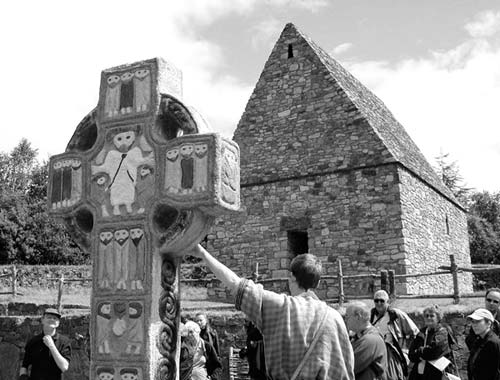
Cost and Hours: €9, daily 9:30-18:30, until 17:30 in winter, last entry 1.5 hours before closing, tel. 053/912-0733, www.inhp.com.
Getting There: It’s clearly signposted on the west end of Wexford—you’ll hit it before entering town on the N-11 Enniscorthy road.
Visiting the Park: Your visit begins with a 15-minute video. Then you have the choice of using a self-paced audioguide or following a live guide on an hour-long tour (hourly 10:00-16:00). Along 16 stops, the guide explains various stages of Irish civilization. The highlight is a monastic settlement from the age when Europe was dark, and Ireland was “the island of saints and scholars.” While you can wander around on your own, the place is a bit childish (there’s nothing actually old here), and only worthwhile if you take the included tour.
Located in Enniscorthy, this museum creatively tells the story of the rise of revolutionary thinking in Ireland, which led to the ill-fated rebellion of 1798 (Ireland’s deadliest). Enniscorthy was the crucial Irish battleground of a populist revolution (inspired by the American and French revolutions). The town witnessed the bloodiest days of the doomed uprising. The material is compelling for anyone intrigued by the struggles for liberty, but there’s little more here than video clips of reenactments and storyboards on the walls.
Cost and Hours: €7; April-Sept Mon-Fri 9:30-17:00, Sat-Sun 12:00-17:00; Oct-March Mon-Fri 9:30-16:00, closed Sat-Sun; last entry one hour before closing, tel. 053/923-7596, www.1798centre.ie.
Getting There: Enniscorthy is 12 miles (19 km) north of Wexford town. The National 1798 Centre is the town’s major sight and is well-signposted (follow the brown Aras 98 Centre signs).
Nearby: Leaving the center, look east across the River Slaney, which divides Enniscorthy, and you’ll see a hill with a stumpy tower on it. This is Vinegar Hill. The tower is the old windmill that once flew the green rebel flag. Drive to the top for the views that the rebels had of the surrounding British forces. The doomed rebels tried desperately to hold the high ground, with no shelter from the merciless British artillery fire.